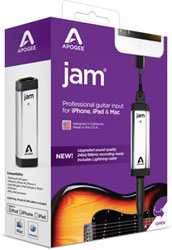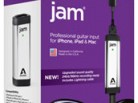Initial Impressions
Apogee has packaged this device cleverly. The front of the box has a fold open flap that lets you get more information and see the actual adapter device. The device itself is small - much smaller than I thought when I saw the pictures originally. It easily fits in your case or even in your pocket. Once we got in the box we found a 30-pin connector, a lightning cable, and a USB cable that allows direct connection to a Mac of your choice. Also included are a Quick Start guide with instructions geared toward using Apple's GarageBand software. I used other programs also to test the versatility but more on that later. The device itself is made from sturdy metal that has a nice chromed nickel finish which should be very durable.
On one end you'll find the standard 1/4" plug your used to on your electronic instruments. The other end is where you'll connect the cable for whichever device you are going to hook up to the Jam. Since this device is compatible with everything iPhone from iPhone 4 to 5s and everything iPad from iPad 2 and newer (including iPad mini) you'll find the included cables are pretty much all you need. If you use another device the USB adapter cable can get you in business. My PC based laptop detected it and was able to fire it up quickly. The USB cable is intended for Mac use, but hey, playing is fun. More on my experiment with a PC later.
A small LED on the front of the unit lets you know that you are connected when blue. Once you hook up your instrument it will turn green to acknowledge input from the instrument. As you play the light can turn red which indicates too much input level. The device has a gain adjustment on its side to control the input level. Obviously a nice solid green is the goal but I found that playing with the gain control let me increase preamp input, which just like an amplifier gain control, increased distortion. With a bass guitar I got a nice fuzz effect which was very musically pleasing. I found a point where both the green and red LED were on that looked kind of orange. I got great results at this point which makes sense as we usually adjust a mic just to the edge of clipping in normal recording. Obviously at this level you'll easily hit the red if you play a little harder but you'll find this is a good color to look for and then just dial the gain back slightly.
Testing
I mentioned I used a bass for some of my testing. Its a pretty stock Epiphone Thunderbird with some Rotosound flat wound strings. For guitar testing I used a Gibson Les Paul Standard Plus which has the Seymour Duncan Jazz and JB pickups I reviewed in another review. These pickups let me test everything from extremely clean to a nice thick rhythm sound with only having to plug into an amp, or in this case, the Jam 96k. I have other guitars that can make nice distortion but if you can't get a good clean tone any effect you add on top of a sound won't make it sound much better. Lastly I used a Taylor electric acoustic for super clean acoustic sounds. For software I used Apple's GarageBand, Amplitube, and Audacity on my PC.
Apogee gears their documentation towards using GarageBand. Since this program is the go to recording software Apple has created this makes sense. Apogee does have a list of other apps that the Jam 96k works with at their site. The Jam 96k is powered by your Apple device so battery charge should be good before you start if you are using a phone. Simply plug in between your Apple device and your instrument. Launch GarageBand. Adjust your gain on the Jam 96k and you are in business to practice or start recording. Since GarageBand has lots of sound packs you'll find everything from a Fender Twin sound to an over-driven Marshall sound and even a Mesa Triple Rectifier for incredible gain. Go nuts and then record whatever you come up with. This is definitely great for a noodler like me but what about the serious musician? There are sound samples on their website showing results pros are getting with this equipment. Since you can launch more sophisticated programs just pull your recorded clips to work with them if editing in GarageBand isn't your thing. Each program can have a learning curve but the Jam gives you an easy way to record your ideas. You'd be surprised the results you can get with GarageBand.
Next I tried Amplitube. The Jam 96k pleased me as much as it did with GarageBand. Another cool feature I like about GarageBand is that I can load Amplitube and its amp models into GarageBand. It even loads the Amplitube interface which I prefer. In Amplitube raising the gain on the Jam 96k reacted how a gain adjustment on an amplifier works - more gain without the fuzz I was getting with GarageBand. Why the difference? It has to be the way the amp models are designed to react to input in the different apps. Since I can load Amplitube into GarageBand it wasn't an issue and gave me more flexible recording options. Amplitube allows you to change speaker cabinets and simulated mics to get different tones. Did I mention that Amplitube has pedal plugins available? This isn't a software review but if you like your pedals here they are. Or better yet - hook up the Jam 96k behind your pedal board and work with the pedals you already know.
Last I tried Audacity which is installed on my PC. The included USB cable worked without a hitch - Windows detected the device and installed its drivers. Unfortunately I kept getting errors in Audacity when I tried to record even though it detected the Jam as my mic. This has to be a software issue which hopefully will get fixed in future versions of Audacity. Apogee doesn't claim the Jam 96k will work with anything but iDevices but it would be nice to have another option for recording. Don't be surprised if the Audacity community works this issue out.
So how do the guitars sound? In a word: fantastic. With the Taylor acoustic there was no coloring of the natural tone. I could get great fat sounds from my bass all the way to that fuzz. With the Les Paul I found fat rhythm sounds all the way to great clean tones. Depending on the output of your instrument you'll find yourself needing to adjust the gain knob on the Jam 96k. Isn't it nice its there instead of having to make adjustments in the software for input level? I appreciate that a lot. I even hooked up my Roland D5 keyboard and got great sounds. Microphones work too but most vocalists like to have a preamp they can adjust. GarageBand has an audio recorder that can serve to record vocals but it won't Autotune you or give you the choir of backup singers effect.
Conclusions
Apogee's Jam 96k is a stellar improvement in home recording. It's like comparing a Model T Ford to a Pontiac GTO. It works seamlessly with the apps in my iDevices and gives professional results. I found that once I started practicing with this setup I suddenly was going to alternate tunings and trying all sorts of new things. That's what technology should do for musicians: spark creativity. The tech shouldn't limit you or lock you into a pattern you don't enjoy.
At $129 some will complain about its cost. Ever bought a professional microphone? How about a mixer to hook it up to? And then the recording device to hook that into? Or how much is a day in a studio to get pro results with an engineer and producer? Arguing value in this situation to anyone who has found themselves buying professional grade equipment to get professional results is pretty silly. Going back to the car analogy you'd have to put a steam train behind the Model T to get the performance of the GTO. Why not just get the GTO?
The interface cables aren't very long so you'll find yourself leaving the Jam 96k close to your iDevice. I hooked mine up with a short pedal board cable and double tape stuck the Jam 96k to my instruments. I just hooked my phone on my guitar strap and used earbuds to listen with. What musician doesn't have tape handy? If this isn't cool for you Apogee has optional 3 meter long cables available. Starting at $25 they aren't cheap but I can see how the short cables that came supplied with the Jam 96k help keep the price down.
Its rare when I get a chance to work with a product that ticks all the boxes and performs as promised. Wish this was true of a lot more stuff.













